by Miriam Campopiano
How was the New World seen and perceived in Early Modern Europe? Did the news in Europe report about what was happening far away? And how?
To answer these questions is not an easy task. The media of the time, handwritten ‘avvisi’ and gazettes, did report news about the European colonies, but the situation was not as straightforward as it may seem.
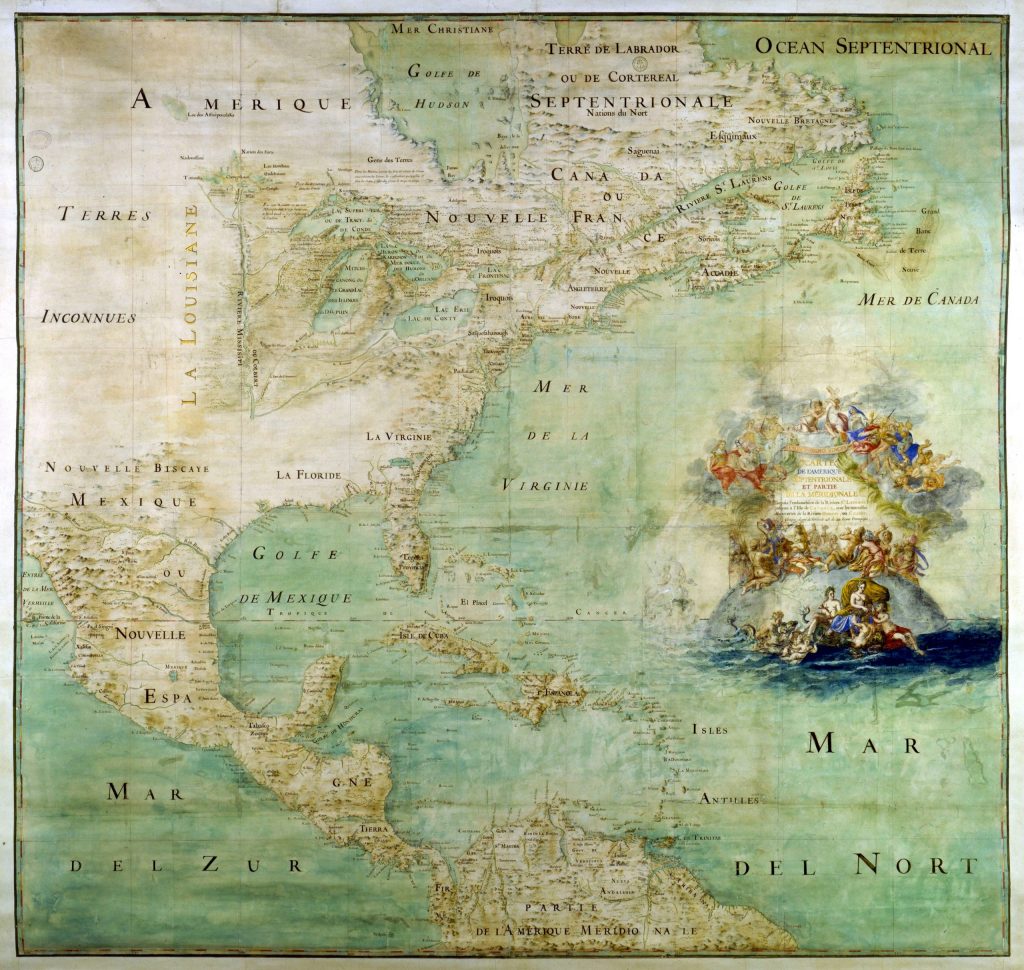
In the State Archive of Florence, we can find many avvisi reporting news from the European colonies. Particularly interesting are those sent by Matteo del Teglia. Postmaster in Venice in the second half of the XVII and the first years of the XVIII centuries, he also took on diplomatic duties. Del Teglia compiled each week a newsletter reporting on the most important news from London, The Hague, Brussels and Hamburg and sent it to Florence and Rome, addressed to prominent Medici family members. The avvisi focused on what was useful to know for the Medici government, so they represent a highly selective compendium of news.
Avvisi were not the only media to report information from the colonies; printed gazettes also acts as purveyors of information. Printed gazettes seem to devote more space to events taking place on the other side of the ocean, much more than the manuscript avvisi. The way news is reported also varies: printed gazettes are more verbose than their manuscript companions. News reported in the avvisi and gazettes was chosen from what was thought more interesting for a European audience. The chief focus was on issues that could directly affect the European balance of power.
In most cases, news reports that refer to the colonies concern the arrival and departure of vessels for commercial and military purposes. Thus, the colonial space was seen through the lens of European commercial and political interests.
Reports of natural disasters that might compromise a harvest or a new commercial agreement can also be commonly found in news reports. Consider the following:
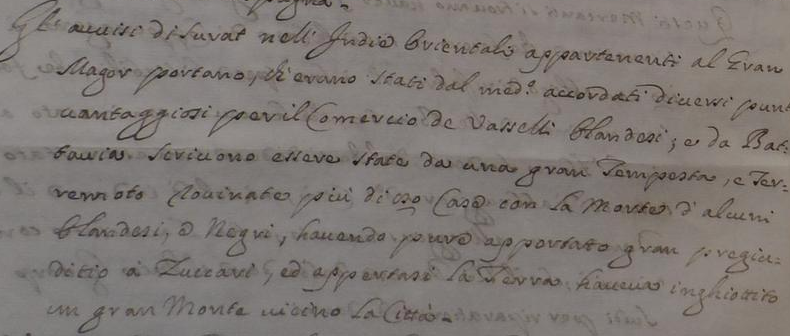
"Gl'avvisi di Surat nell'Indie Orientali appartenenti al Gran Magor portano, ch'erano stati medesimo accordati diversi punti vantaggiosi per il comercio de vaselli Olandesi, e da Battavia [Jakarta] scrivono essere state da una gran tempesta, e terremoto rovinate più di 80 case con la morte d'alcuni Olandesi, e negri, havendo pure apportato gran pregiuditio à Zuccari, ed appertasi la Terra haveva inghiottito un gran monte vicino la città."
[The avvisi of Surat in the East Indies belonging to the Grand Magor [Grand Moghul Aurangzeb (1618-1707)] report that several advantageous points for the trade of Dutch pots had been agreed upon, and from Battavia [Jakarta] they write that more than 80 houses were ruined by a great storm and earthquake, with the death of some Dutchmen and Negroes, as well as ruining the sugar plantations, and that the earth was swallowed up a large mountain near the city.]
When we compare news from the same place in the same month in the avvisi by Del Teglia and in the Corriere Ordinario printed in Vienna: we found, for instance, that there is more information in the Corriere Ordinario than in the handwritten news sheets.
However, this does not mean that we cannot find the same piece of news in both handwritten avvisi and printed gazettes. The same news item can be reported in a different context, or in a different way, and sometimes (even if those cases are rare) we find the same news reported almost identically.
An example is news of a new remedy for intestinal disorders reported in both the handwritten newsletter and the Corriere Ordinario:
|
Handwritten news sheet (ASF, MdP, 4191a, f. 182r) |
Printed Gazette (Bologna, 7 settembre 1700) |
|
Londra 13 Agosto 1700 […] Molte Famiglie di Protestanti venute e dalli Svizzeri vanno à stabilirisi à Capo Buona Speranza, e dalla Coralina [Carolina] scrivono, che gl' indiani habbino trovato un’eccellente cordiale, e rimedio universale contro il Flato, Renalla, Pietra, et altri mali col mezzo d'un’Ambra Grigia. [Many families of Protestants have come and from the Swiss are going to settle at Cape Good Hope, and from Carolina it is written, that the Indians have found an excellent cordial, and universal remedy against Flatus renal calculi, kidney stones, and other evils by means of ambergris.] |
LONDRA 13. detto. [13/08/1700] […] Il Rè hà comprato tutto il Salnitro venuto con tre Vascelli dall’Indie Orientali per il valore di 10.m. lire sterline; Lettere dalla Carolina portano, che s’era trovato un rimedio mirabile per la Colisa, Renella, e Pietra, & altri mali interni col mezzo di cert’Ambra griggia prendendosi con qualche bevanda. [The King has bought all the saltpetre which came with three vessels from the East Indies for the value of 10,000 pounds sterling; letters from Carolina bring news that a marvellous remedy has been found for colic, kidney stones, renal calculi and other internal ills by means of certain ambergris taken with some drink.] |
Of course, major events are followed by news publications, such as the Scottish attempt to colonize the Darien. Both manuscript avvisi and printed gazettes reported news of this expedition. Europeans watched conflicts in the colonial territories closely since they were well aware of the repercussions in the Old Continent.
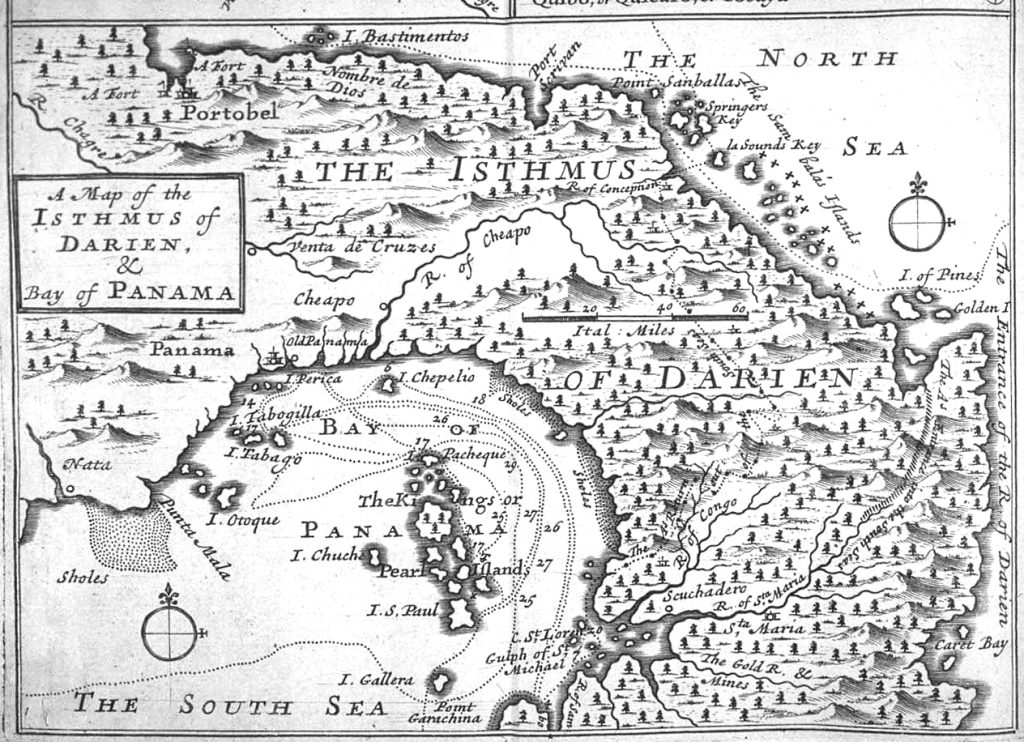
In the year 1695 “The Company of Scotland Trading to Africa and the Indies” was founded. The main promoter of this enterprise was the economist, William Paterson. It was thanks to him that the Scottish Company was established, and it was Peterson who chose the Isthmus of Darien as a territory to conquer. His idea was to take advantage of the position of Darien, near the Isthmus of Panama, as a crossroads of trade routes, rather than exploiting the richness of the land. Peterson considered Darien to be the «door to the seas and key to the universe», given the opportunities offered by this enterprise. But the plan did not go as well as expected and the “Darien Scheme” turned out to be a failure. As a matter of fact, historians held that the economic difficulties that struck Scotland after the Darien enterprise were among the main reasons why it eventually merged with the Crown of England in 1707.
Contemporaries followed this effort carefully because its success or failure could have upset the economic, and consequently the political settlement in the British Isles and therefore in the whole continent. More than that it was a reason for confrontation between Spain and Scotland. The territory of Darien, in fact, had not been claimed by any sovereign, but fell within the Spanish sphere of influence.
The first fleet sailed from Scotland on 19 July 1698 and reached Darien in October of the same year. After days of negotiation with the local tribes, the Scots finally established their colony. Darien was renamed “New Caledonia” and a fort was built and called Fort Saint Andrew. As soon as the news came to Europe the troubles begun.
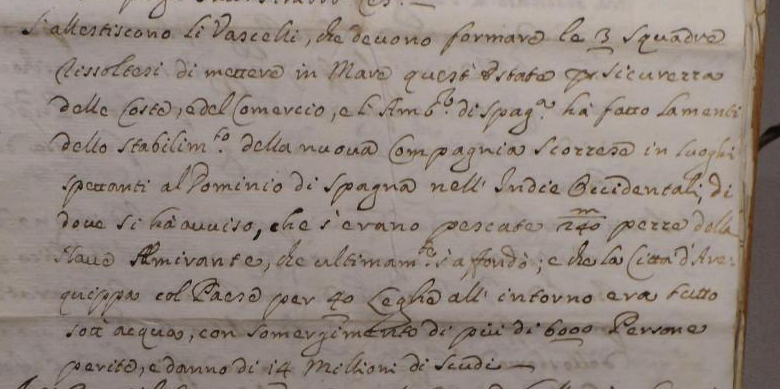
"Londra 24 Aprile 99 [24/04/1699] […] L’Ambasciatore di Spagna hà fatto lamenti dello stabilimento della nuova Compagnia Scozzese in luoghi spettanti al Dominio di Spagna nell’Indie Occidentali, di dove si hà avviso, che s’erano pescate 240mila pezze dalla Nave Almirante, che ultimamente s’affondò…"
[The Spanish Ambassador has complained about the establishment of the new Scottish Company in places which belong to the Dominion of Spain in the West Indies, from which it has been reported that 240,000 pezze [piastre d’argento, a Tuscan unit of currency] were recovered from the ship Almirante, which recently sank…]
The Spanish prepared an attack on New Caledonia in April 1699 but it was stopped by bad weather. The Scottish though were facing other difficulties: the weather, tropical diseases, desertions, and the denial of any kind of support from the others British colonies. In June 1699 the Scots were so few that they decided to leave the colony. But the strangest thing happened: a second group arrived to reinforce the Scots when they had already left. The official correspondence did not mention the abandonment of New Caledonia, but the rumors reached Edinburgh, so the directors of the Company decided to send reinforcements for what they thought was a colony in difficulty. Thus, the Scots reestablished their presence in the area. But this time there was no bad weather to keep the Spanish away. After two months of skirmish and siege the Scots capitulated.
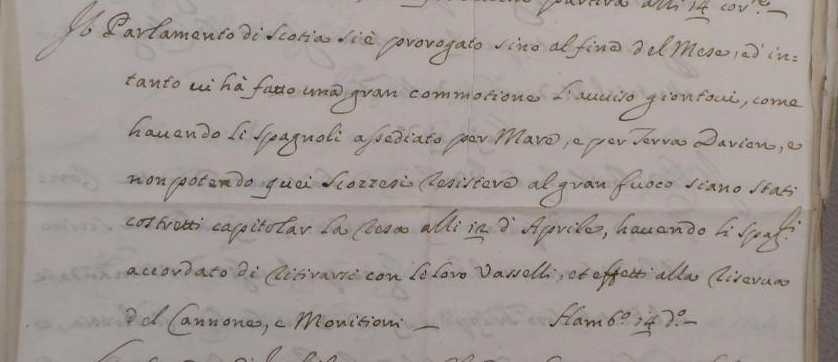
"Il Parlamento di Scotia si è prorogato sino al fine del mese, ed intanto vi hà fatto una gran commotione l'avviso giontovi, come havendo li Spagnoli assediato per mare, e per Terra Darien, e non potendo quei scozzesi resistere al gran fuoco siano stati costretti capitolar la resa alli 12 d'Aprile, havendo li Spagnoli accordato di ritirarsi con li loro vasselli, et effetti alla riserva del cannone, e monitioni."
[The Parliament of Scotland has adjourned until the end of the month, and in the meantime there has been great consternation from the news that the Spanish have besieged Darien by sea and land, and not being able to resist the fierce fire, they were forced to surrender on the 12th of April,the Spaniards having agreed to withdraw with their vessels and supplies except for cannons and munitions].
After 1700 news of Darién's exploits became less and less prominent, and there was no further media coverage because Scotland had by this time come into the English orbit and had lost the potential which had fed the interest of the gazettes and the avvisi in the first place.
FURTHER READING
- Bingham H., The Early History of the Scots Darien Company, in “The Scottish Historical Review”, a. III n. 10, gennaio 1906, pp. 210- 217.
- Blair A. et alii (editors), Information: A historical companion, Princeton University Press, Princeton 2021.
- Chartier R., La mano dell’autore, la mente dello stampatore. Cultura e scrittura nell’Europa moderna, Carocci, Roma 2014.
- R. Hidalgo, To get rich for Our Homeland: The Company of Scotland and the Colonization of the Isthmus of Darien, in “Colonial Latin America Historical Review”, a. III, n.10, giugno 2001, pp. 322-350.
- Horton M., ‘To Transmit to Posterity the Virtue, Lustre and th Glory of the Ancestors’: Scottish Pioneers in Darien Panama, in Caroline A. Williams (editor), Bridging the Early Modern Atlantic World. People, Products, and Practices on the Move, Ashgate, Farham 2009, p. 131-150.
- Mario Infelise, Prima dei giornali, Editore Laterza, Roma-Bari 2005.
- Prebble J., The Darien Disaster, Pimlico, London 2002.
Miriam Campopiano is Junior Research Fellow in the EURONEWS Project. In 2020, she joined the Internship program coordinated by Dr. Davide Boerio. During the internship she analyzed a series of avvisi which became the primary sources for her MA thesis “D'America si tiene avviso" Information, Politics and Religion in the Colonial Universe (1698-1701)’. In February 2022, she successfully defended her thesis at the University of Naples “Federico II”, obtaining 110/100 cum laude. She has also been awarded with a generous fellowship granted by the Director Alessio Assonitis for attending the 2022 Winter Paleographic and Archival Seminar at the Medici Archive Project in Florence.
